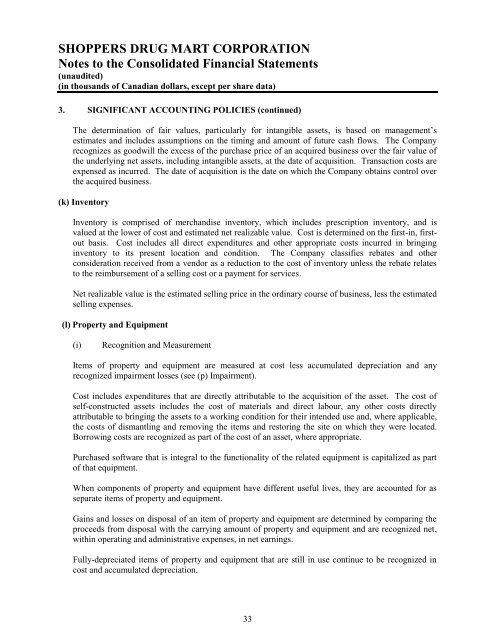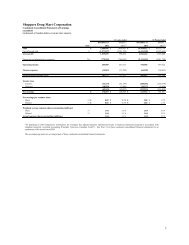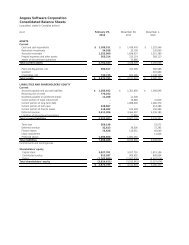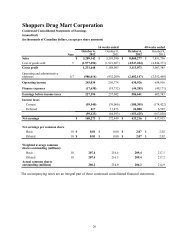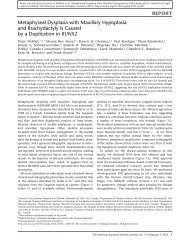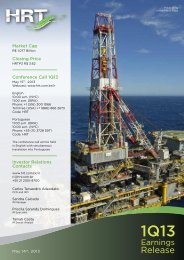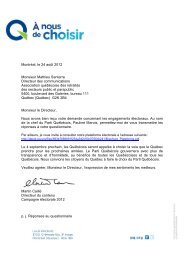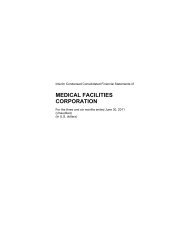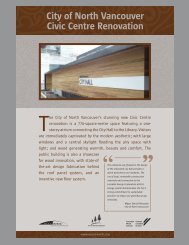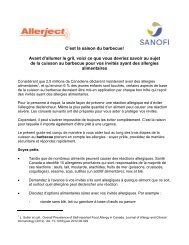Financial Statements of - Shoppers Drug Mart
Financial Statements of - Shoppers Drug Mart
Financial Statements of - Shoppers Drug Mart
Create successful ePaper yourself
Turn your PDF publications into a flip-book with our unique Google optimized e-Paper software.
SHOPPERS DRUG MART CORPORATION<br />
Notes to the Consolidated <strong>Financial</strong> <strong>Statements</strong><br />
(unaudited)<br />
(in thousands <strong>of</strong> Canadian dollars, except per share data)<br />
3. SIGNIFICANT ACCOUNTING POLICIES (continued)<br />
The determination <strong>of</strong> fair values, particularly for intangible assets, is based on management’s<br />
estimates and includes assumptions on the timing and amount <strong>of</strong> future cash flows. The Company<br />
recognizes as goodwill the excess <strong>of</strong> the purchase price <strong>of</strong> an acquired business over the fair value <strong>of</strong><br />
the underlying net assets, including intangible assets, at the date <strong>of</strong> acquisition. Transaction costs are<br />
expensed as incurred. The date <strong>of</strong> acquisition is the date on which the Company obtains control over<br />
the acquired business.<br />
(k) Inventory<br />
Inventory is comprised <strong>of</strong> merchandise inventory, which includes prescription inventory, and is<br />
valued at the lower <strong>of</strong> cost and estimated net realizable value. Cost is determined on the first-in, firstout<br />
basis. Cost includes all direct expenditures and other appropriate costs incurred in bringing<br />
inventory to its present location and condition. The Company classifies rebates and other<br />
consideration received from a vendor as a reduction to the cost <strong>of</strong> inventory unless the rebate relates<br />
to the reimbursement <strong>of</strong> a selling cost or a payment for services.<br />
Net realizable value is the estimated selling price in the ordinary course <strong>of</strong> business, less the estimated<br />
selling expenses.<br />
(l) Property and Equipment<br />
(i)<br />
Recognition and Measurement<br />
Items <strong>of</strong> property and equipment are measured at cost less accumulated depreciation and any<br />
recognized impairment losses (see (p) Impairment).<br />
Cost includes expenditures that are directly attributable to the acquisition <strong>of</strong> the asset. The cost <strong>of</strong><br />
self-constructed assets includes the cost <strong>of</strong> materials and direct labour, any other costs directly<br />
attributable to bringing the assets to a working condition for their intended use and, where applicable,<br />
the costs <strong>of</strong> dismantling and removing the items and restoring the site on which they were located.<br />
Borrowing costs are recognized as part <strong>of</strong> the cost <strong>of</strong> an asset, where appropriate.<br />
Purchased s<strong>of</strong>tware that is integral to the functionality <strong>of</strong> the related equipment is capitalized as part<br />
<strong>of</strong> that equipment.<br />
When components <strong>of</strong> property and equipment have different useful lives, they are accounted for as<br />
separate items <strong>of</strong> property and equipment.<br />
Gains and losses on disposal <strong>of</strong> an item <strong>of</strong> property and equipment are determined by comparing the<br />
proceeds from disposal with the carrying amount <strong>of</strong> property and equipment and are recognized net,<br />
within operating and administrative expenses, in net earnings.<br />
Fully-depreciated items <strong>of</strong> property and equipment that are still in use continue to be recognized in<br />
cost and accumulated depreciation.<br />
33


